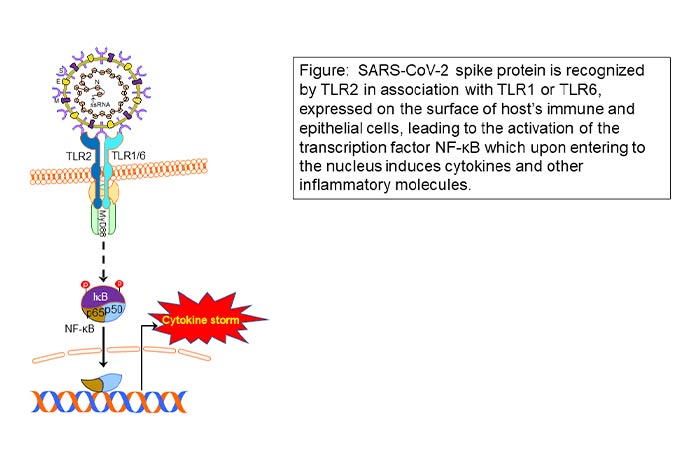Blocking TLR2 could calm COVID-19’s cytokine storm

Although COVID-19 is known for its respiratory symptoms, people with the disease sometimes launch an overwhelming immune response, called the cytokine storm, which can also be deadly. UT Southwestern scientists are closing in on the mechanism for this hyperinflammatory response.

In an eLife study, Hasan Zaki, Ph.D., Assistant Professor of Pathology, and his colleagues explored a cell surface protein called toll-like receptor 2 (TLR2) and its relationship to the flood of inflammatory molecules, or cytokines, released during COVID-19 infection. Shahanshah Khan, Ph.D., a postdoctoral fellow in the Zaki lab, was lead author.
“The cytokine storm is a major cause of cell death and organ damage in SARS-CoV-2-infected patients,” Dr. Zaki explained. “Understanding how the hyperinflammatory response is activated during SARS-CoV-2 infection could ultimately help define new strategies for treating COVID-19.”
To better understand COVID-19’s cytokine storm, Dr. Zaki and his colleagues exposed human and mouse immune cells to each of the four major structural proteins that make up SARS-CoV-2:
- the spike protein, which allows the virus to infect and enter cells;
- the membrane protein, which is essential for viral replication;
- the envelope protein, which is important for assembly, release, and virulence; and
- the nucleocapsid protein, which packages the viral genome. Of these, only the spike protein caused these immune cells to produce inflammatory cytokines.
They observed that TLR2, working with one of two other proteins, TLR1 or TLR6, acts as the sensor on cell exteriors that responds to the spike protein. Digging deeper, they found that immune and lung epithelial cells isolated from animals genetically altered to lack TLR2 didn’t produce inflammatory cytokines when exposed to the spike protein. The same was true with cells exposed to chemical agents that blocked TLR2 or had undergone a genetic editing technique to disable this protein. Recognition of spike protein by TLR2 leads to the activation of the cell-signaling molecules resulting in the activation of the transcription factor NF-kB, which is responsible for the expression of cytokines and other inflammatory molecules the constituting the cytokine storm.
Dr. Zaki noted that if further research confirms this finding, COVID-19 therapies may eventually include drugs that block TLR2 to prevent or treat the cytokine storm.
“Cytokines play important roles in the immune system, but in excess, they can be very detrimental,” Dr. Zaki said. “By carefully selecting patients for treatments that suppress TLR2 function, we may be able to significantly improve COVID-19 outcomes and reduce death.”
UTSW co-authors include: Christopher Longoria, B.S., Research Associate; John W. Schoggins, Ph.D., Associate Professor of Microbiology; Rashmin C. Savani, M.D., Professor of Pediatrics.
The study received support from The National Institute of Diabetes and Digestive and Kidney Diseases of the National Institute of Health (NIH R01DK125352 and AI158254, the Cancer Prevention and Research Institute of Texas (RP200284), the American Cancer Society (RSG-21-021-01-TBE). Dr. Savani is funded by a Sponsored Research Agreement with Mallinckrodt Pharmaceuticals Inc. for an unrelated project.
Dr. Savani holds The William Buchanan Chair in Pediatrics.
Dr. Schoggins is the Nancy Cain and Jeffrey A. Marcus Scholar in Medical Research, in Honor of Dr. Bill S. Vowell.

